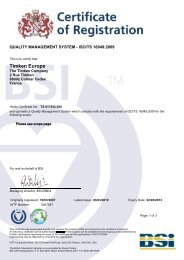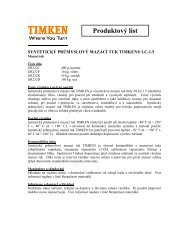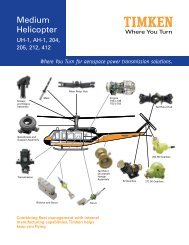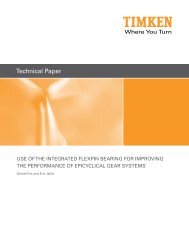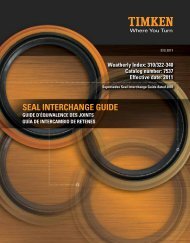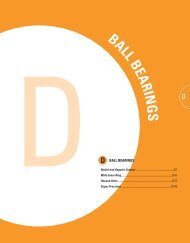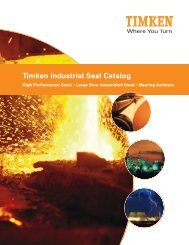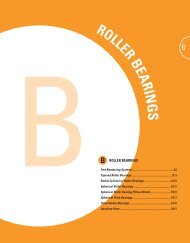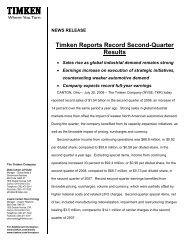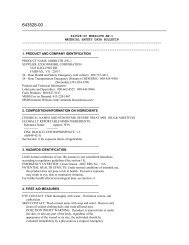Material Safety Data Sheet Material Safety Data Sheet - Timken
Material Safety Data Sheet Material Safety Data Sheet - Timken
Material Safety Data Sheet Material Safety Data Sheet - Timken
Create successful ePaper yourself
Turn your PDF publications into a flip-book with our unique Google optimized e-Paper software.
Texaco Multifak® EP<br />
<strong>Material</strong> <strong>Safety</strong> <strong>Data</strong> <strong>Sheet</strong><br />
MSDS: 8644<br />
Revision #: 2 Revision Date: 7/30/2002<br />
Click here to search the product data sheet database<br />
<strong>Material</strong> <strong>Safety</strong> <strong>Data</strong> <strong>Sheet</strong><br />
24-Hour Emergency Telephone Numbers<br />
HEALTH : ChevronTexaco Emergency Information Center (800) 231-0623 or (510) 231-0623<br />
TRANSPORTATION : CHEMTREC (800) 424-9300 or (703) 527-3887<br />
Emergency Information Centers are located in the U.S.A. International collect calls accepted.<br />
SECTION 1 PRODUCT AND COMPANY IDENTIFICATION<br />
TEXACO Multifak EP<br />
Product Number(s): CPS220901, CPS220921, CPS220995<br />
Synonyms: TEXACO Multifak EP 0, TEXACO Multifak EP 1, TEXACO Multifak EP 2<br />
Company Identification<br />
ChevronTexaco Global Lubricants<br />
6001 Bollinger Canyon Road<br />
San Ramon, CA 94583<br />
United States of America<br />
SECTION 2 COMPOSITION/ INFORMATION ON INGREDIENTS<br />
Product Information<br />
Product Information: 800-LUBE-TEK<br />
email : lubemsds@chevron.com<br />
COMPONENTS CAS NUMBER AMOUNT<br />
Highly refined mineral oil (C15-C50) Mixture 75 - 94.99 %weight<br />
Zinc alkyl dithiophosphate 68649-42-3 1 - 2.99 %weight<br />
Non-hazardous additive blend in refined oil Other 10 - 19.99 %weight<br />
SECTION 3 HAZARDS IDENTIFICATION<br />
999-10522-0903
************************************************************************************************************************<br />
EMERGENCY OVERVIEW<br />
Grease<br />
************************************************************************************************************************<br />
IMMEDIATE HEALTH EFFECTS<br />
Eye: Not expected to cause prolonged or significant eye irritation.<br />
Skin: Contact with the skin is not expected to cause prolonged or significant irritation. Not expected to be<br />
harmful to internal organs if absorbed through the skin. High-Pressure Equipment Information: Accidental<br />
high-velocity injection under the skin of materials of this type may result in serious injury. Seek medical<br />
attention at once should an accident like this occur. The initial wound at the injection site may not appear<br />
to be serious at first; but, if left untreated, could result in disfigurement or amputation of the affected part.<br />
Ingestion: Not expected to be harmful if swallowed.<br />
Inhalation: Not expected to be harmful if inhaled. Contains a petroleum-based mineral oil. May cause<br />
respiratory irritation or other pulmonary effects following prolonged or repeated inhalation of oil mist at<br />
airborne levels above the recommended mineral oil mist exposure limit. Symptoms of respiratory irritation<br />
may include coughing and difficulty breathing.<br />
SECTION 4 FIRST AID MEASURES<br />
Eye: No specific first aid measures are required. As a precaution, remove contact lenses, if worn, and<br />
flush eyes with water.<br />
Skin: No specific first aid measures are required. As a precaution, remove clothing and shoes if<br />
contaminated. To remove the material from skin, apply a waterless hand cleaner, mineral oil, or petroleum<br />
jelly. Then wash with soap and water. Discard contaminated clothing and shoes or thoroughly clean<br />
before reuse.<br />
Ingestion: No specific first aid measures are required. Do not induce vomiting. As a precaution, get<br />
medical advice.<br />
Inhalation: No specific first aid measures are required. If exposed to excessive levels of material in the<br />
air, move the exposed person to fresh air. Get medical attention if coughing or respiratory discomfort<br />
occurs.<br />
Note to Physicians: In an accident involving high-pressure equipment, this product may be injected<br />
under the skin. Such an accident may result in a small, sometimes bloodless, puncture wound. However,<br />
because of its driving force, material injected into a fingertip can be deposited into the palm of the hand.<br />
Within 24 hours, there is usually a great deal of swelling, discoloration, and intense throbbing pain.<br />
Immediate treatment at a surgical emergency center is recommended.<br />
SECTION 5 FIRE FIGHTING MEASURES<br />
FIRE CLASSIFICATION:<br />
OSHA Classification (29 CFR 1910.1200): Not classified by OSHA as flammable or combustible.<br />
NFPA RATINGS: Health: 0 Flammability: 1 Reactivity: 0<br />
FLAMMABLE PROPERTIES:<br />
Flashpoint: (Cleveland Open Cup) 392 °F (200 °C) (Min)<br />
Autoignition: NDA<br />
Flammability (Explosive) Limits (% by volume in air): Lower: NA Upper: NA<br />
EXTINGUISHING MEDIA: Use water fog, foam, dry chemical or carbon dioxide (CO2) to extinguish<br />
flames.
PROTECTION OF FIRE FIGHTERS:<br />
Fire Fighting Instructions: This material will burn although it is not easily ignited. For fires involving this<br />
material, do not enter any enclosed or confined fire space without proper protective equipment, including<br />
self-contained breathing apparatus.<br />
Combustion Products: Highly dependent on combustion conditions. A complex mixture of airborne<br />
solids, liquids, and gases including carbon monoxide, carbon dioxide, and unidentified organic<br />
compounds will be evolved when this material undergoes combustion. Combustion may form oxides of:<br />
Phosphorus, Sulfur, Zinc .<br />
SECTION 6 ACCIDENTAL RELEASE MEASURES<br />
Protective Measures: Eliminate all sources of ignition in vicinity of spilled material.<br />
Spill Management: Stop the source of the release if you can do it without risk. Contain release to prevent<br />
further contamination of soil, surface water or groundwater. Clean up spill as soon as possible, observing<br />
precautions in Exposure Controls/Personal Protection. Use appropriate techniques such as applying noncombustible<br />
absorbent materials or pumping. Where feasible and appropriate, remove contaminated soil.<br />
Place contaminated materials in disposable containers and dispose of in a manner consistent with<br />
applicable regulations. Clean up spills immediately, observing precautions in Exposure Controls/Personal<br />
Protection section.<br />
Reporting: Report spills to local authorities and/or the U.S. Coast Guard's National Response Center at<br />
(800) 424-8802 as appropriate or required.<br />
SECTION 7 HANDLING AND STORAGE<br />
Precautionary Measures: Keep out of the reach of children.<br />
General Handling Information: Avoid contaminating soil or releasing this material into sewage and<br />
drainage systems and bodies of water.<br />
Static Hazard: Electrostatic charge may accumulate and create a hazardous condition when handling<br />
this material. To minimize this hazard, bonding and grounding may be necessary but may not, by<br />
themselves, be sufficient. Review all operations which have the potential of generating an accumulation<br />
of electrostatic charge and/or a flammable atmosphere (including tank and container filling, splash filling,<br />
tank cleaning, sampling, gauging, switch loading, filtering, mixing, agitation, and vacuum truck operations)<br />
and use appropriate mitigating procedures. For more information, refer to OSHA Standard 29 CFR<br />
1910.106, 'Flammable and Combustible Liquids', National Fire Protection Association (NFPA 77,<br />
'Recommended Practice on Static Electricity', and/or the American Petroleum Institute (API)<br />
Recommended Practice 2003, 'Protection Against Ignitions Arising Out of Static, Lightning, and Stray<br />
Currents'.<br />
Container Warnings: Container is not designed to contain pressure. Do not use pressure to empty<br />
container or it may rupture with explosive force. Empty containers retain product residue (solid, liquid,<br />
and/or vapor) and can be dangerous. Do not pressurize, cut, weld, braze, solder, drill, grind, or expose<br />
such containers to heat, flame, sparks, static electricity, or other sources of ignition. They may explode<br />
and cause injury or death. Empty containers should be completely drained, properly closed, and promptly<br />
returned to a drum reconditioner or disposed of properly.<br />
SECTION 8 EXPOSURE CONTROLS/PERSONAL PROTECTION<br />
GENERAL CONSIDERATIONS:<br />
Consider the potential hazards of this material (see Section 3), applicable exposure limits, job activities,<br />
and other substances in the work place when designing engineering controls and selecting personal<br />
protective equipment. If engineering controls or work practices are not adequate to prevent exposure to
harmful levels of this material, the personal protective equipment listed below is recommended. The user<br />
should read and understand all instructions and limitations supplied with the equipment since protection is<br />
usually provided for a limited time or under certain circumstances.<br />
ENGINEERING CONTROLS:<br />
Use in a well-ventilated area.<br />
PERSONAL PROTECTIVE EQUIPMENT<br />
Eye/Face Protection: No special eye protection is normally required. Where splashing is possible, wear<br />
safety glasses with side shields as a good safety practice.<br />
Skin Protection: No special protective clothing is normally required. Where splashing is possible, select<br />
protective clothing depending on operations conducted, physical requirements and other substances.<br />
Suggested materials for protective gloves include: Neoprene, Nitrile Rubber, Silver Shield.<br />
Respiratory Protection: No respiratory protection is normally required.<br />
If user operations generate an oil mist, determine if airborne concentrations are below the occupational<br />
exposure limit for mineral oil mist. If not, wear an approved respirator that provides adequate protection<br />
from the measured concentrations of this material. For air-purifying respirators use a particulate cartridge.<br />
Use a positive pressure air-supplying respirator in circumstances where air-purifying respirators may not<br />
provide adequate protection.<br />
Occupational Exposure Limits:<br />
Component Limit TWA STEL Ceiling Notation<br />
Highly refined mineral oil (C15-<br />
C50)<br />
Highly refined mineral oil (C15-<br />
C50)<br />
ACGIH_TLV 5 mg/m3 10 mg/m3<br />
OSHA_PEL 5 mg/m3<br />
SECTION 9 PHYSICAL AND CHEMICAL PROPERTIES<br />
Attention: the data below are typical values and do not constitute a specification.<br />
Appearance and Odor: Grease<br />
pH: NA<br />
Vapor Pressure: 1<br />
Boiling Point: >500 °F (>260 C)<br />
Solubility: Soluble in hydrocarbons; insoluble in water<br />
Freezing Point: NA<br />
Melting Point: 350 F (177 °C) (Min) Dropping Point<br />
Specific Gravity:
Hazardous Decomposition Products: Hydrogen Sulfide (Elevated temperatures)<br />
Hazardous Polymerization: Hazardous polymerization will not occur.<br />
SECTION 11 TOXICOLOGICAL INFORMATION<br />
IMMEDIATE HEALTH EFFECTS<br />
Eye Irritation: The eye irritation hazard is based on evaluation of data for similar materials or product<br />
components.<br />
Skin Irritation: The skin irritation hazard is based on evaluation of data for similar materials or product<br />
components.<br />
Skin Sensitization: No product toxicology data available.<br />
Acute Dermal Toxicity: The acute dermal toxicity hazard is based on evaluation of data for similar<br />
materials or product components.<br />
Acute Oral Toxicity: The acute oral toxicity hazard is based on evaluation of data for similar materials or<br />
product components.<br />
Acute Inhalation Toxicity: The acute inhalation toxicity hazard is based on evaluation of data for similar<br />
materials or product components.<br />
ADDITIONAL TOXICOLOGY INFORMATION:<br />
This product contains petroleum base oils which may be refined by various processes including severe<br />
solvent extraction, severe hydrocracking, or severe hydrotreating. None of the oils requires a cancer<br />
warning under the OSHA Hazard Communication Standard (29 CFR 1910.1200). These oils have not<br />
been listed in the National Toxicology Program (NTP) Annual Report nor have they been classified by the<br />
International Agency for Research on Cancer (IARC) as; carcinogenic to humans (Group 1), probably<br />
carcinogenic to humans (Group 2A), or possibly carcinogenic to humans (Group 2B).<br />
SECTION 12 ECOLOGICAL INFORMATION<br />
ECOTOXICITY<br />
The toxicity of this material to aquatic organisms has not been evaluated. Consequently, this material<br />
should be kept out of sewage and drainage systems and all bodies of water.<br />
ENVIRONMENTAL FATE<br />
This material is not expected to be readily biodegradable.<br />
SECTION 13 DISPOSAL CONSIDERATIONS<br />
Oil collection services are available for used oil recycling or disposal. Place contaminated materials in<br />
containers and dispose of in a manner consistent with applicable regulations. Contact your sales<br />
representative or local environmental or health authorities for approved disposal or recycling methods.<br />
SECTION 14 TRANSPORT INFORMATION<br />
The description shown may not apply to all shipping situations. Consult 49CFR, or appropriate Dangerous<br />
Goods Regulations, for additional description requirements (e.g., technical name) and mode-specific or<br />
quantity-specific shipping requirements.<br />
DOT Shipping Name: NOT REGULATED AS A HAZARDOUS MATERIAL FOR TRANSPORTATION<br />
UNDER 49 CFR
DOT Hazard Class: NOT APPLICABLE<br />
DOT Identification Number: NOT APPLICABLE<br />
DOT Packing Group: NOT APPLICABLE<br />
Additional Information: NOT HAZARDOUS BY U.S. DOT. ADR/RID HAZARD CLASS NOT<br />
APPLICABLE.<br />
SECTION 15 REGULATORY INFORMATION<br />
SARA 311/312 CATEGORIES: 1. Immediate (Acute) Health Effects: NO<br />
2. Delayed (Chronic) Health Effects: NO<br />
3. Fire Hazard: NO<br />
4. Sudden Release of Pressure Hazard: NO<br />
5. Reactivity Hazard: NO<br />
REGULATORY LISTS SEARCHED:<br />
4_I1=IARC Group 1 15=SARA Section 313<br />
4_I2A=IARC Group 2A 16=CA Proposition 65<br />
4_I2B=IARC Group 2B 17=MA RTK<br />
05=NTP Carcinogen 18=NJ RTK<br />
06=OSHA Carcinogen 19=DOT Marine Pollutant<br />
09=TSCA 12(b) 20=PA RTK<br />
Zinc alkyl dithiophosphate 15<br />
CHEMICAL INVENTORIES:<br />
CANADA: All the components of this material are on the Canadian DSL or have been notified under the<br />
New Substance Notification Regulations, but have not yet been published in the Canada Gazette.<br />
UNITED STATES: All of the components of this material are on the Toxic Substances Control Act (TSCA)<br />
Chemical Inventory.<br />
NEW JERSEY RTK CLASSIFICATION:<br />
Under the New Jersey Right-to-Know Act L. 1983 Chapter 315 N.J.S.A. 34:5A-1 et. seq., the product is to<br />
be identified as follows:<br />
PETROLEUM OIL (Grease)<br />
WHMIS CLASSIFICATION:<br />
This product is not considered a controlled product according to the criteria of the Canadian Controlled<br />
Products Regulations.<br />
SECTION 16 OTHER INFORMATION<br />
NFPA RATINGS: Health: 0 Flammability: 1 Reactivity: 0<br />
HMIS RATINGS: Health: 1 Flammability: 1 Reactivity: 0<br />
(0-Least, 1-Slight, 2-Moderate, 3-High, 4-Extreme, PPE:- Personal Protection Equipment Index
ecommendation, *- Chronic Effect Indicator). These values are obtained using the guidelines or<br />
published evaluations prepared by the National Fire Protection Association (NFPA) or the National Paint<br />
and Coating Association (for HMIS ratings).<br />
REVISION STATEMENT: Changes have been made throughout this <strong>Material</strong> <strong>Safety</strong> <strong>Data</strong> <strong>Sheet</strong>. Please<br />
read the entire document.<br />
ABBREVIATIONS THAT MAY HAVE BEEN USED IN THIS DOCUMENT:<br />
TLV - Threshold Limit Value TWA - Time Weighted Average<br />
STEL - Short-term Exposure Limit PEL - Permissible Exposure Limit<br />
NDA - No <strong>Data</strong> Available NA - Not Applicable<br />
CAS - Chemical Abstract Service Number<br />
= - Greater Than or Equal To<br />
Prepared according to the OSHA Hazard Communication Standard (29 CFR 1910.1200) and the ANSI<br />
MSDS Standard (Z400.1).<br />
The above information is based on the data of which we are aware and is believed to be correct<br />
as of the date hereof. Since this information may be applied under conditions beyond our control<br />
and with which we may be unfamiliar and since data made available subsequent to the date<br />
hereof may suggest modifications of the information, we do not assume any responsibility for the<br />
results of its use. This information is furnished upon condition that the person receiving it shall<br />
make his own determination of the suitability of the material for his particular purpose.



